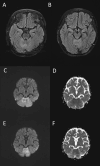Wernicke Encephalopathy in a Child With Acute Lymphoblastic Leukemia: A Case Report
- PMID: 40548495
- PMCID: PMC12183601
- DOI: 10.1002/cnr2.70235
Wernicke Encephalopathy in a Child With Acute Lymphoblastic Leukemia: A Case Report
Abstract
Background: Wernicke encephalopathy (WE) is a life-threatening neurological disorder caused by thiamine deficiency, commonly associated with alcoholism but also observed in malnourished pediatric cancer patients undergoing intensive chemotherapy. WE remains underdiagnosed in children, with many cases only confirmed postmortem. We report a 6-year-old girl with acute lymphoblastic leukemia (ALL) who developed WE secondary to treatment-resistant nausea and vomiting.
Case: The patient presented with acute gait disturbance, ophthalmoparesis, and paraparesis following persistent vomiting and significant weight loss. Initial diagnostic evaluations, including cerebrospinal fluid analysis and neuroimaging, suggested alternative diagnoses such as cerebellitis and Guillain-Barré Syndrome. However, progressive neurological deterioration, the emergence of encephalopathy, and follow-up magnetic resonance imaging (MRI) findings of hyperintense lesions in the periventricular, periaqueductal, and cerebellar regions supported the diagnosis of WE. The overlapping features with other neurological conditions contributed to a delay in recognizing WE and initiating thiamine therapy. Despite initiating high-dose intravenous thiamine, symptom resolution was significant but partial. Unfortunately, the patient later developed lymphomatous meningitis and sepsis and ultimately succumbed to complications.
Conclusion: This case highlights the importance of early clinical recognition of WE in pediatric leukemia patients with prolonged vomiting, as delayed diagnosis can lead to irreversible neurological damage or death. Given the limitations of early neuroimaging findings, clinical suspicion should prompt immediate thiamine supplementation. The report points out the need for heightened awareness of thiamine deficiency in pediatric oncology, emphasizing the role of prophylactic supplementation in high-risk patients.
Keywords: Wernicke encephalopathy; acute lymphoblastic leukemia; pediatric oncology; thiamine deficiency.
© 2025 The Author(s). Cancer Reports published by Wiley Periodicals LLC.
Conflict of interest statement
The authors declare no conflicts of interest.
Figures



Similar articles
-
Wernicke Encephalopathy Associated with Crohn's Disease.Acta Med Indones. 2025 Apr;57(2):251-256. Acta Med Indones. 2025. PMID: 40641204
-
Dynamic progression of Wernicke encephalopathy in a gastric cancer patient: Multimodal MRI insights with arterial spin labeling perfusion imaging.Medicine (Baltimore). 2025 Aug 8;104(32):e43580. doi: 10.1097/MD.0000000000043580. Medicine (Baltimore). 2025. PMID: 40797436 Free PMC article.
-
Wernicke Encephalopathy in an Adolescent With Severe Genetic Obesity and Hyperphagia.Pediatrics. 2025 Sep 1;156(3):e2024070439. doi: 10.1542/peds.2024-070439. Pediatrics. 2025. PMID: 40759408
-
When time is brain: a systematic review about Wernicke encephalopathy as a dramatic consequence of thiamin deficiency in hyperemesis gravidarum.J Matern Fetal Neonatal Med. 2023 Dec;36(2):2223678. doi: 10.1080/14767058.2023.2223678. J Matern Fetal Neonatal Med. 2023. PMID: 37322816
-
Wernicke Encephalopathy Presenting with Dysphagia: A Case Report and Systematic Literature Review.Nutrients. 2022 Dec 13;14(24):5294. doi: 10.3390/nu14245294. Nutrients. 2022. PMID: 36558453 Free PMC article.
References
-
- Ota Y., Capizzano A. A., Moritani T., Naganawa S., Kurokawa R., and Srinivasan A., “Comprehensive Review of Wernicke Encephalopathy: Pathophysiology, Clinical Symptoms and Imaging Findings,” Japanese Journal of Radiology 38, no. 9 (2020): 809–820. - PubMed
-
- Lallas M. and Desai J., “Wernicke Encephalopathy in Children and Adolescents,” World Journal of Pediatrics 10, no. 4 (2014): 293–298. - PubMed
-
- Isenberg‐Grzeda E., Rahane S., DeRosa A. P., Ellis J., and Nicolson S. E., “Wernicke‐Korsakoff Syndrome in Patients With Cancer: A Systematic Review,” Lancet Oncology 17, no. 4 (2016): e142–e148. - PubMed
Publication types
MeSH terms
Substances
LinkOut - more resources
Full Text Sources

